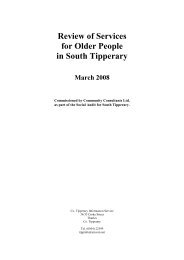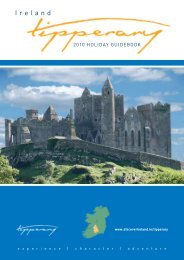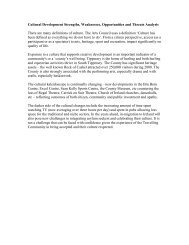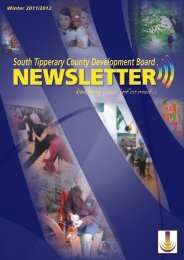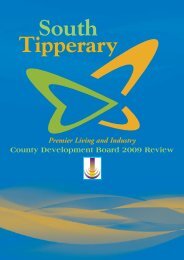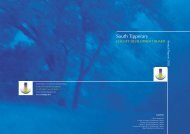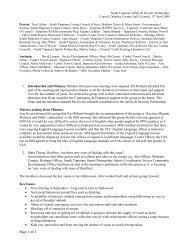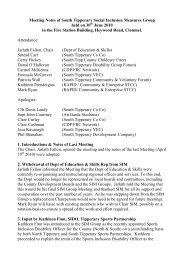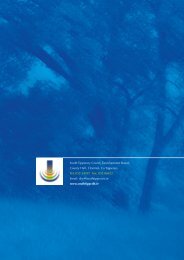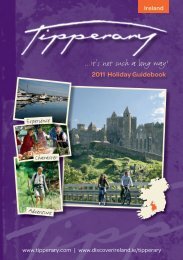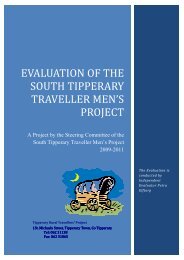Appendix 2 17.pdf - South Tipperary County Development Board
Appendix 2 17.pdf - South Tipperary County Development Board
Appendix 2 17.pdf - South Tipperary County Development Board
You also want an ePaper? Increase the reach of your titles
YUMPU automatically turns print PDFs into web optimized ePapers that Google loves.
Public Consultations (January-March, consultation meeting reports with: local<br />
government; tourist sector; business pillar; small and medium sized enterprise;<br />
Travelling community; youth sector; performance arts; visual arts; sports and<br />
recreation; heritage.<br />
CULTURAL CONSULTATIVE MEETING REPORT<br />
Conservation/Heritage Sector (February 20, 2001)<br />
Cahir Craft Granary – Chair Pat Holland – Notetaker John Quinn<br />
Present:<br />
Joe Ahern, Cahir<br />
Fr George Bourke, Cappawhite<br />
Peig Butler, Cahir<br />
Marie Casey, Craft Granary<br />
Eddie Dalton, Old Cashel Society<br />
Patsy Fitzgerald, Carrick on Suir Heritage Centre<br />
Denis Hartnett, <strong>Tipperary</strong> & District Historical Society<br />
Pat Holland, <strong>Tipperary</strong> SR Co Council<br />
Gerry Kaar, Clonmel<br />
Ger O’Brien, Cahir<br />
Joseph O’Connor, Thomastown, Golden<br />
Mary O’Connor, <strong>Tipperary</strong> & District Historical Society<br />
Kitty O’Donovan, <strong>Tipperary</strong> & District Historical Society<br />
Barry O’Reilly, Moyglass<br />
John Quinn, <strong>County</strong> <strong>Development</strong> <strong>Board</strong><br />
Dan Ryan, Ayle, Oola<br />
Mary Ryan, Toom, Cappawhite<br />
Desmond Short, Cahir<br />
Sr Mary Walsh, <strong>South</strong> <strong>Tipperary</strong> Voluntary Community Group Platform<br />
Apologies<br />
Maureen Ahern, Cahir<br />
Michael Hall, Mullinahone (written submission received)<br />
Liam O’Duibhir, Clonmel<br />
Summary<br />
The Consultative Meeting’s vision for the future is that:<br />
There is both a heritage officer and conservation office employed by<br />
<strong>Tipperary</strong> SR Co Council. (A priority action area for the heritage officer<br />
would include a ‘visual education strategy for heritage).<br />
A policy on collections is in place at <strong>County</strong> level<br />
That there are realistic (conditions strong on heritage element but not<br />
insurmountable on matching requirements) grants available for the heritage<br />
sector within the <strong>County</strong><br />
1. The big issues/concerns to the conservation/heritage sector
Changes in the landscape – a particular concern about the obliteration<br />
of townland and other boundaries and landscape features<br />
Vernacular Architecture (thatched houses etc)<br />
Preservation of collections – important to put conservation elements in<br />
place; an agreed policy to sustain collections if voluntary group<br />
managers are unable to continue<br />
Access to resources supported by the public purse – for example<br />
genealogical records; there needs to be heritage input into policy<br />
regarding what happens to collections and data bases of voluntary<br />
groups supported by public money (in the event of the voluntary group<br />
ceasing operations)<br />
Restoration of historic buildings – making these buildings safe; ideally<br />
finding new uses for them, but sometimes there cannot be practical<br />
uses and the heritage needs to be preserved for what it is.<br />
Access to and preservation of archaeological monuments – many of<br />
our best field monuments are not easily accessed. There is a safety and<br />
insurance issue with regard to visitors on private land. There is also a<br />
deterioration issue.<br />
Access to attractions managed by public bodies – limited opening<br />
times; convincing arguments needed to keep sites open<br />
Visual education and public awareness – a major challenge to get<br />
across an appreciation of heritage<br />
Lack of co-ordination among public bodies regarding heritage<br />
Planning and heritage – are satisfactory structures in place (example on<br />
inappropriate telephone box placed in Cahir Heritage Town<br />
Funding – difficult to access and often requires major matching<br />
funding; an integrated funding policy for heritage is needed<br />
Training – the heritage sector is largely based on the voluntary sector.<br />
There are difficulties in attracting volunteers, especially young people.<br />
There is a need for structures which encourage volunteers/FAS<br />
workers to get qualifications in looking after collections and heritage
CULTURAL CONSULTATIVE MEETING REPORT<br />
PERFORMING ARTS SECTOR (February 19, 2001)<br />
<strong>Tipperary</strong> Town Enterprise Centre – Chair Paul Grisewood – Notetaker John Quinn<br />
Present:<br />
Don Andrews, Cappawhite<br />
Paul Grisewood, <strong>Tipperary</strong> Excel<br />
Jim Keane, Golden<br />
Aisling Kilroy, Clonmel<br />
Brendan Maher, <strong>South</strong> <strong>Tipperary</strong> Arts Centre<br />
Jim Myers, Clonmel<br />
William O’Dwyer, Bansha, Visual Arts (Painting)<br />
Lynda Phelan, The Place Performance Studio<br />
John Quinn, <strong>County</strong> <strong>Development</strong> <strong>Board</strong><br />
Patricia Ryan, <strong>Tipperary</strong> Youth Theatre<br />
David Teeven, Galloglass Theatre, Clonmel<br />
Summary<br />
The key challenge for the performing arts sector remains the same as it was in 1996 –<br />
how can the arts sector build an infrastructure that will optimize its potential for the<br />
county. Strong Leadership is needed. Who is prepared to lead the arts sector at county<br />
level Also, a clear understanding of the benefits of a coherent approach to<br />
supporting arts needs to be conveyed to critical decision makers in the county.<br />
The <strong>County</strong> Cultural Strategy represents another opportunity to get ‘arts’ right in<br />
<strong>South</strong> <strong>Tipperary</strong>. The ‘Performance Arts Sector’ volunteers to participate in the<br />
process of preparing and implementing the <strong>County</strong> Cultural Strategy.<br />
2. Vision for the future – what the consultative group would like to see that<br />
is additional to the cultural situation of <strong>South</strong> <strong>Tipperary</strong> by 2010<br />
Retaining its strengths in the performing arts arena with <strong>South</strong><br />
<strong>Tipperary</strong> performing artists and groups continuing to perform with<br />
excellence at home and abroad<br />
A municipal Theatre in Clonmel<br />
Improved performing arts venues (building in each main town that is<br />
accessible by performing arts groups and that a quality sound/lighting<br />
infrastructure or alternatively easy access for sound/lighting<br />
equipment; there is also a need for a good community hall in every<br />
community that can accommodate both practice and performance of<br />
arts groups).<br />
<strong>County</strong> Arts team located within the local authority structure<br />
(including an Arts Officer, Marketing Officer, Product <strong>Development</strong><br />
Officer)<br />
Coherent approach by arts practitioners (unified approach to a shared<br />
vision)
A performing arts sector that is exposed to international trends and is<br />
clear about the bigger picture (new trends in crosscutting arts, dance,<br />
video, etc).<br />
More significant per capita spend on performing arts in <strong>South</strong><br />
<strong>Tipperary</strong><br />
Access to the arts for all – a much wider population both participating<br />
in and enjoying performance arts in <strong>South</strong> <strong>Tipperary</strong>.<br />
3. How does <strong>South</strong> <strong>Tipperary</strong> rate from a performing arts perspective<br />
<strong>South</strong> <strong>Tipperary</strong> has a good arts center in Clonmel. But the Arts Centre does not have<br />
the capacity (physical and financial) to cope with the demands of the performing arts<br />
sector.<br />
<strong>South</strong> <strong>Tipperary</strong> does not have a municipal theatre. A municipal theatre is needed to<br />
encourage performing artists and to build the audience among the general population<br />
for performance arts. It is difficult to marry the needs of the performance arts sector<br />
with the availability and constraints of a commercial theatre. The municipal theatre<br />
should ideally be based in Clonmel. While a municipal theatre could be on a green<br />
field site, cognizance must also be taken of the efforts to save the Regal Theatre.<br />
Cashel has the Bru Boru Centre. There is a perception that Bru Boru is under-utilised.<br />
It is not an ideal venue in terms of bringing in equipment and sets. <strong>Tipperary</strong> Town<br />
will shortly have the Excel Centre. This centre will be available on a set number of<br />
nights in the year for performance arts. The Excel Centre has an artistic policy. Again<br />
because of the tightness of the site, access with equipment will also not be easy.<br />
Carrick on Suir has a strong Amateur Drama tradition but is in need of a bigger<br />
theatre.<br />
Given that the benefits of Arts Officer are generally acknowledged (more per capita<br />
spend on arts, more diversity in arts sectors, improved average with regard to quality<br />
of performance in the performance arts sector, information office for the arts sector,<br />
initiatives such as artists in residence, etc), a key question is why does <strong>Tipperary</strong><br />
(<strong>South</strong> riding) Co Council not employ a dedicated Arts Officer<br />
The <strong>County</strong> Council proposes to draw up an Arts Strategy in 2001. This Arts strategy<br />
needs to focus on supporting the growth and development of the arts in <strong>South</strong><br />
<strong>Tipperary</strong>. The performing groups represented at the consultative meeting earn more<br />
income from many other local authorities than they do from local authorities in <strong>South</strong><br />
<strong>Tipperary</strong>. <strong>South</strong> <strong>Tipperary</strong> is perceived to be un-supportive of arts by contrast with<br />
other areas (in terms of suitable premises, level of financial support, general<br />
encouragement, easy access to advice, etc). There is a danger that the best of the<br />
artists, teachers, etc will migrate to other counties.<br />
The performing arts sector in <strong>South</strong> <strong>Tipperary</strong> includes groups which are<br />
internationally competitive (groups that have been invited to perform abroad).<br />
There is good co-operation within the performance arts sector in <strong>South</strong> <strong>Tipperary</strong> –<br />
amateur and professional. The <strong>South</strong> <strong>Tipperary</strong> Arts Network initiated an Arts and<br />
Cultural Plan 1996-2000. Disappointment was expressed at the consultative meeting<br />
that more of the key recommendations in the 1996-2000 Plan had not been achieved.<br />
These key recommendations included:
An increased per capita arts spend ( – nationally there is much more support<br />
coming from the Arts Council)<br />
A permanent position for an arts officer with a public art brief (not achieved)<br />
The development of a new <strong>County</strong> Museum (achieved)<br />
Clarification of the role of two emerging arts centers (this recommendation not<br />
reviewed at the consultative meeting).<br />
Many young people from <strong>South</strong> <strong>Tipperary</strong> coming to performing art classes have<br />
never been inside a theatre. There is considerable publicity regarding teenage drinking<br />
but are other options available for youth throughout the county Performing arts<br />
should not be perceived as social work but there are positive social outcomes from<br />
developing the artistic side of each person. Youth development is likely to be an<br />
aspiration of the <strong>County</strong> Social Strategy – why not then more support for youth arts<br />
Some performance arts have become dormant since 1996 – for instance, street theatre<br />
in Cappawhite.<br />
4. Opportunities and threats<br />
The <strong>County</strong> <strong>Development</strong> <strong>Board</strong> has been charged with overseeing the design and<br />
implementation of a <strong>County</strong> Cultural Strategy. The <strong>County</strong> Cultural Strategy has to<br />
agreed by consensus. While there is no guarantee that specific bodies such as the Co<br />
Council will take the views of the performing arts sector on board, the evolvement of<br />
the Cultural Strategy does present an opportunity to build consensus about what is<br />
needed for the future. It may be that another lead agency for the arts/culture is agreed<br />
at <strong>County</strong> level and that this agreed agency could negotiate with the Arts Council and<br />
other sectors represented at the <strong>County</strong> <strong>Development</strong> <strong>Board</strong> table for resources to<br />
deliver the levels of arts services required in the county. The ‘Arts’ need a champion<br />
at a senior level both in the <strong>County</strong> <strong>Development</strong> <strong>Board</strong> and in the Local Authority.<br />
Changes in school curricula may offer an opportunity to advance the arts agenda in<br />
the county. Drama may become a Leaving Certificate examination subject (additional<br />
to being a LCAP subject).<br />
Cognisance needs to be taken on the national experience regarding arts officers.<br />
Analysis of the Arts Officer experience indicates that what is required in each <strong>County</strong><br />
is an Arts Team. If the Arts Team is located in the local authority, it needs to be<br />
headed up by a senior manager with specific designated posts. These posts could be<br />
vertical (culture, heritage, marketing, product development, etc) or horizontal (with<br />
specific posts for each art form). The threat is that there will be no resourced Arts<br />
Office/r in <strong>South</strong> <strong>Tipperary</strong> in the medium term future. There is an opportunity to<br />
engage with the <strong>County</strong> Council as it prepares Arts Strategy in 2001.<br />
Cognisance also needs to be taken of what is happening internationally. The<br />
performance arts sector is constantly being re-defined. There is a trend towards<br />
mixing, where performance arts are crossing over. <strong>South</strong> <strong>Tipperary</strong> needs to access<br />
the opportunity of being exposed to best ‘performance’. Britain is one country well<br />
worth looking at.<br />
Ownership is an important issue in relation to access and sustainability. Community<br />
ownership (eg <strong>Tipperary</strong> Community Radio) is perceived to be very successful from a<br />
performing arts perspective in the <strong>Tipperary</strong> Town area.
A possible threat is that funding for the arts (such as the Access) may be withdrawn.<br />
This funding has been of great assistance to the development of infrastructure.<br />
A performing arts strategy should not be associated with tourism. Tourists can<br />
provide an additional market.<br />
The Performing Arts Sector needs to help provide the vision and also the coherence.<br />
If its members see themselves as competing with other members of the sector, the<br />
opportunity to bring the changes sought will diminish.<br />
Volunteers/Comments on process used by the CDB to date<br />
David and Jim volunteered to join the Cultural Working Group. Patricia is to check if<br />
any member of the <strong>Tipperary</strong> Youth Theatre is to volunteer. It was also recommended<br />
that Bill Meaney from Carrick on Suir be requested to join the CDB Cultural Working<br />
Group.<br />
Lynda volunteered to make a presentation on the best international practice regarding<br />
performance arts to the Cultural Working Group (February 26).<br />
John is to circulate the list of stakeholders identified by the Cultural Working Group<br />
members to all members of the Working Group prior to the next meeting (February<br />
26). Members are requested to identify any gaps in the stakeholder list.<br />
Defining culture is very difficult. The danger is that the definition would be too<br />
parochial. Culture needs to accommodate what is new as well as what is old. It is<br />
important that the culture of <strong>South</strong> <strong>Tipperary</strong> is open to new influences.<br />
It is confusing to mention professionalism and commercial groups in the same<br />
context. A professional group is not necessarily commercial. A commercial group is<br />
not necessarily professional, in fact many of the commercial initiatives come from the<br />
voluntary sector.
CULTURAL CONSULTATIVE MEETING REPORT<br />
Sport and Recreation sector (February 21, 2001)<br />
Abymill Theatre, Fethard – Chair John Dalton, Guestspeaker Anne Marie Maher,<br />
Notetakers Breda O’Connor and John Quinn<br />
Present:<br />
Peggy Colville, <strong>County</strong> Community Games<br />
Bridget Cuddihy, Fethard<br />
Dick Cummins, Fethard<br />
John Dalton, <strong>South</strong> <strong>Tipperary</strong> Voluntary Community Group Platform<br />
Michael Delany, Ballypatrick<br />
Cllr John Fahey, <strong>Tipperary</strong> SR Co Council/VEC<br />
Gus Fitzgerald, Fethard<br />
Brian Guiry, Fethard<br />
Maureen Guiry, Fethard<br />
Peter Hogan, Clonmel<br />
Francis Kearney, Scoil Ruain, Killenaule<br />
Ursula Kehoe McGarry, Kilsheelan<br />
Brendan Kenny, Fethard<br />
Kevin Lalor, Lisronagh<br />
Anne Marie Maher, Sports and Leisure Officer, Laois Co Council<br />
Joe Moran, Presentation Secondary School, Ballingarry<br />
Nicholas Moroney, Drangan<br />
Breda O’Connor, <strong>County</strong> <strong>Development</strong> <strong>Board</strong><br />
Arthur O’Donnell, <strong>South</strong> <strong>Tipperary</strong> Local sports Partnership<br />
Padraig O Sealbhaigh<br />
Niall O’Sullivan, Knocklofty<br />
John Quinn, <strong>County</strong> <strong>Development</strong> <strong>Board</strong><br />
Agnes Williamson, Mullinahone<br />
Jim Hennessey<br />
Apologies:<br />
Noel Davern TD, Minister of State, Department of Agriculture and Food<br />
Martin O’Keeffe, Cahir<br />
Emby Walsh, Carrick on Suir<br />
Summary<br />
48% of people do not take part in sport. Participation decreases as one gets older. The<br />
focus of sports strategy needs to be on practical ways of increasing the physical<br />
activity of many of those who engage in sports and recreation and the 48% who do<br />
not. Target groups need to be identified, consulted and advised/co-ordinated on how<br />
best to access sport and recreation. Because many people have not been successful at<br />
sports at a younger age, as parents they may lack the confidence to engage with and<br />
support their children in participating in sport. The Local sports Partnership has coordinated<br />
a bid for resources based on themes of encouraging volunteerism, upskilling<br />
volunteers, promoting co-operation, participation and excellence.<br />
5. Highlights of the presentation by Anne Marie Maher, Sports and Leisure<br />
Officer, Laois Co Council
Laois Recreation and Sports Forum established in 1997. Co Council<br />
agreed to recruit a Sports and Leisure Officer.<br />
The key issues arising from community sport surveys related to<br />
participation; facilities; finance; large target groups not participating;<br />
training and education; organizational structures and coaches/human<br />
resources. Sport is dying because of a lack of appreciation of<br />
volunteers. Variety in sport exists more by coincidence (champion)<br />
than planning. The changes in work and lifestyles is a major reason<br />
why parents do not become involved. 78% of sports clubs were GAA<br />
clubs. There was nothing else in seven parishes in the county.<br />
An agreed vision– increased participation by people of all ages and<br />
abilities in leisure, recreation and sport.<br />
Detailed survey of sports in the county currently being carried out and<br />
programmes being introduced and promoted to target groups (New<br />
activities, targeted activities, leadership training and information and<br />
advice; also more activity by sports bodies, especially the GAA on<br />
club development).<br />
Local Sports Partnership formalized in 2000-2001 to optimize the<br />
potential of new directions in Sport for Co Laois.<br />
6. Comments from the audience<br />
Does a Sports Officer make a difference Laois has had 27 applications for the recent<br />
round of funding under the Sports Capital Programme. Does anyone know how many<br />
there were in <strong>South</strong> <strong>Tipperary</strong> More than 70 volunteers have participated in training<br />
programmes, many in the 17-25 age group. Regular contact is maintained with these<br />
volunteers and all bar eight are currently giving their expertise to sports development<br />
in Laois.<br />
Will the new approach of the Irish Sports Council just not result in more<br />
administration with still very small sums being available for direct action in sport and<br />
recreation The VEC could carry administration costs and the budget made available<br />
to their Sports Advisory Bodies was all allocated! – The general approach used by the<br />
VECs was to divide the small budget by the numbers of applications and give<br />
everybody a small grant. The Irish Sports Council is trying to take the politics out of<br />
sport and bring more professionalism into the way it is run in each county.<br />
The model of the Citizens Information Centres is a case in point – the direct service is<br />
provided by volunteers but in the bigger centers a manager/coordinator is hired to<br />
ensure that the system can operate efficiently – that volunteer time is all directed at<br />
service rather than being bogged down in administration, form filling, fund sourcing,<br />
etc. Another advantage of the new system is that the Local Sports Partnership will be<br />
asked for opinions in relation to the allocation of the Sports Capital Funding<br />
resources.<br />
Will money be targeted towards innovation in the new system Yes, but there will be<br />
local decision making on the priorities. There will also be scope for emphasis on<br />
target groups other than youth groups. For example in Laois, the Mountmellick area is<br />
proposing an initiative involving the introduction of five new sports per year for a<br />
three year period.
Volunteers have a concern about payments. In the past all volunteers gave their time<br />
voluntarily and all were treated the same. The Laois approach is more about<br />
appreciating volunteers rather than paying them. You cannot pay for the amount of<br />
commitment volunteers give. The profile of volunteers is that they are in it for the<br />
long haul – almost everybody in the audience has given 20 years voluntary support to<br />
sport in parts of <strong>South</strong> <strong>Tipperary</strong>. The focus needs to be on developing well trained,<br />
well motivated volunteers.<br />
Some parents see sport as a babysitting service. Yes, it is a real challenge to involve<br />
parents but many of them are afraid of being laughed at, that they have nothing to<br />
offer because they may not have been very good at sport themselves. Sport needs to<br />
be taken out of the ‘expert’ box. If a woman walking along the road is taught the<br />
proper way to walk, then there is no reason why she cannot in turn pass on those skills<br />
to others.<br />
7. Who takes part in sport Who does not What can be done to increase<br />
participation in <strong>South</strong> <strong>Tipperary</strong><br />
48% of people do not take part in sport. Participation decreases as one gets older.<br />
For those aged 60+, the focus needs to be on supporting Active Retirement Clubs.<br />
This age group generally enjoys dance and effort is required to ensure that these<br />
groups do not have sedentary programmes only.<br />
For those age 40+, there are challenges. Some have just left team sports. There is a<br />
need for access to facilities and sports that suit that age group (pitch and putt courses,<br />
sli na slainte, etc).<br />
For shift workers, planning is required to include rather than exclude them – facilities,<br />
coaching needs to be available on a rota basis. The principle to follow is to enable<br />
people participate in activity at times that suit them. Many halls are under-utilised and<br />
adult groups do not need supervision. Encouragement of people to participate in work<br />
recreation outings may get some non-participants interested. The Health <strong>Board</strong>s are<br />
also supporting workplace health promotion initiatives.<br />
For school children, there is a need to upskill teachers or encourage flexible<br />
approaches where more coaches are available to the school. Children are entitled to<br />
two periods (40 minutes) of physical activity each week. Legal and insurance issues<br />
are a concern as is the profile of teachers (some of whom may not be physically<br />
active). FAS has resourced 123 placements of a sport and leisure nature (£2.4 million<br />
spent annually in <strong>South</strong> <strong>Tipperary</strong>). Lack of continuity is an issue with good coaches<br />
often lost because of the time conditions pertaining to the schemes.<br />
For children without parental support – focus on parents with very young children and<br />
on helping them to learn skills which in turn will help their children to play.<br />
Encourage more sports participation and variety at primary level. Research for the<br />
National Children’s Strategy has indicated that all those up to age 18 want more<br />
access to sport and recreation.<br />
For teenagers – cycling lanes and a focus on learning new leisure activities and not for<br />
competition. Also more emphasis on sports participation in second level schools.
8. Key Themes of the Local Sports Partnership in <strong>South</strong> <strong>Tipperary</strong><br />
Arthur O’Donnell and Peggy Colville of the co-ordinating committee of the Local<br />
Sports Partnership in <strong>South</strong> <strong>Tipperary</strong> were present and agreed that the key themes of<br />
the Local Sports Partnership’s bid for resources could be included with the notes of<br />
the meeting.<br />
The themes on which the <strong>South</strong> <strong>Tipperary</strong> Local Sports Partnership would focus<br />
2001 has been designated as Year of the Volunteer. The shortage and Volunteers<br />
has been identified as a critical issue for all groups consulted in the preparation of<br />
this application.<br />
A second key issue is qualifications and skills of the volunteers assisting sports<br />
development work. The <strong>South</strong> <strong>Tipperary</strong> Local Sports Partnership propose to<br />
concentrate on both recruitment and up-skilling throughtTraining and promotion.<br />
In particular, enabling volunteers to achieve qualifications may be achieved by the<br />
establishment a Diploma/Cert/Degree Outreach programme for existing Coaches,<br />
giving consideration to their experience, specialisation and committed enthusiasm.<br />
<strong>Tipperary</strong> Institute will be a key partner in achieving up-skilling goals.<br />
Promote better co-operation, minimise duplication and pool resources to get better<br />
value for money (<strong>County</strong> <strong>Development</strong> <strong>Board</strong> structures will be an asset to the<br />
Local Sports Partnership in agreeing protocols between various bodies and in<br />
gaining consensus on a <strong>County</strong> Cultural strategy (including a <strong>County</strong> Sports<br />
Strategy. The CDB proposes that the Local Sports Partnership be the body to<br />
develop consensus on the <strong>County</strong> Sports Strategy).<br />
Develop a Three Year Co Sports Strategy with emphasis on: more participation;<br />
greater access by disadvantaged and minority groups; increased use of public and<br />
community facilities (including access to schools during holiday periods);<br />
establish, promote and support Schools of Schools of Sporting Excellence, with a<br />
view to increased participation (work with U.L); develop new approaches to<br />
maximise the potential of sports to address the problem of early school leaving<br />
and to overcome the challenge of some young people giving-up sport in school;<br />
implement a Code of Ethics in all sports; update, repair and promote the Long<br />
Distance Walks, especially the <strong>South</strong> Munster Way.
CULTURAL CONSULTATIVE MEETING REPORT<br />
VISUAL ARTS SECTOR (February 22, 2001)<br />
<strong>South</strong> <strong>Tipperary</strong> Arts Centre – Chair Brendam Maher – Notetaker John Quinn<br />
Present:<br />
Bernard Coleman, <strong>Tipperary</strong> Town<br />
Dolores Fennessy, <strong>South</strong> <strong>Tipperary</strong> Arts Centre<br />
Ronnie Fitzgerald, <strong>South</strong> <strong>Tipperary</strong> Arts Centre<br />
Geraldine Loyer, carrick on Suir<br />
Michael W. Loyer, Carrick on Suir<br />
Brendan Maher, <strong>South</strong> <strong>Tipperary</strong> Arts Centre<br />
John Marshall, Kilfeacle<br />
Fr Gerard O’Connor, <strong>South</strong> <strong>Tipperary</strong> Voluntary Community Group Platform<br />
Maureen Purcell, <strong>South</strong> <strong>Tipperary</strong> Arts Centre<br />
John Quinn, <strong>County</strong> <strong>Development</strong> <strong>Board</strong><br />
Michael Quinn, <strong>Tipperary</strong> Town<br />
Miriam D. Robinson, Clonmel<br />
Desmond Short, Cahir<br />
Summary<br />
The visual arts sector needs to be aware of the unmet needs of three groups:<br />
Professional artists who need access to facilities to produce, display and sell<br />
their work<br />
The general arts community (non-professional artists, teachers and audiences<br />
for/buyers of art) who value the contribution of art to their quality of life but<br />
need access to art and supports when promoting it<br />
Other adults in the community who are not connected to art (and may fear art<br />
or not see the benefits of art) and their children who may in the future also fail<br />
to appreciate the value of art.<br />
The onus is on the visual arts sector to bridge the gap between artists and their<br />
communities as well as creating/maintaining structures that will continue to facilitate<br />
the development and promotion of visual arts in <strong>South</strong> <strong>Tipperary</strong>.<br />
9. What are the needs of the visual arts community<br />
Workshop space for professionals – ideally in one location with a<br />
central gallery area for their exhibitions.<br />
More public commissions, especially in forms of art other than<br />
sculpture. The value of artists is appreciated in public art contracts.<br />
Art college students need an opportunity to show their work – these<br />
shows can also attract back their original classmates to their home<br />
towns.<br />
Need to bring the joy of visual arts to disadvantaged groupings in the<br />
community – especially children of parents who have limited income.
There is a challenge to get the disadvantaged sector involved in arts<br />
and the arts community needs to discover ways of doing that.<br />
Promoting visual arts to grow the local audience means taking a twintracked<br />
approach – via children and via adults. It seems attractive to<br />
promote arts to children. Children are enthusiastic and willing to do<br />
things. However as children grow older, they are more likely to behave<br />
as parents behave rather than what parents say. There also needs to be<br />
promotion to parents and also to both parents and children together.<br />
The trap to avoid is making art that is accessible only to children. It is<br />
important to focus in promotion campaigns on adults and how to bring<br />
visual arts to them.<br />
The media we use has an important role to play in promotion. Pictures<br />
convey more information than words. Billboards in shop windows;<br />
samples of exhibitions brought to school gymnasia; use of a website<br />
which documents pictorially previous exhibitions and also includes<br />
critical reviews of abstract pieces; computer terminals available to<br />
access art (for example, other exhibitions going on nationally); links<br />
into local websites – an arts section for example in the website –<br />
Clonmel.ie -.<br />
10. How can the gap between visual arts sector and the community be<br />
bridged It is getting better but not getting better fast enough! How does<br />
the visual arts sector maximize its communication with the general<br />
community<br />
Peoples perceptions of visual arts in the community vary from –<br />
disinterest on one extreme to those who hold the visual arts in awe<br />
(and are afraid to participate) on the other extreme.<br />
Do local communities ever see the work of artists (including students)<br />
who come from or reside in their community People’s perceptions of<br />
artists are that artists are separate from the community<br />
Outreach programmes provide an opportunity to link the professional<br />
with the community.<br />
Teachers play a role in visual education. What are the links between<br />
the visual arts sector and teachers What supports do teachers need to<br />
develop the visual capacity of their pupils<br />
Many adults can understand figurative paintings in the traditional style<br />
but are confused by other forms of art. Artists feel that the work<br />
explains itself and expect the audience to interrogate the work rather<br />
than the artist. Members of the community may need reference points<br />
in order to understand art.<br />
There is a conundrum between the need of the artist to confront society<br />
with his/her work which may need a visually articulate environment to<br />
be understood and the need of the community which may need further<br />
visual education in order to understand the work.
If people come into a visual exhibition, they are likely to have more<br />
than a minimum level of visual awareness. There is an onus on the<br />
audience to deal with the work. However if an artist goes out to a<br />
community, there is an onus on the artist to create a safe environment<br />
where the community can develop the visual awareness capacity of its<br />
members.<br />
People grow by forming their own opinions (of an artistic piece of<br />
work) and possibly reforming them if they get added information. A<br />
catalogue can assist the process of understanding by including a critical<br />
review of the work (not an explanation) particular if the work is<br />
abstract.<br />
Outreach work is particularly productive – there could be a target of<br />
outreach to an electoral area each year (five-year period)



